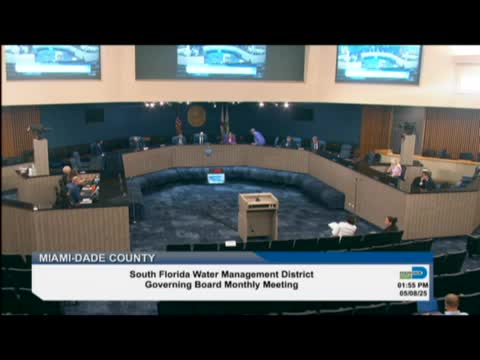Water managers assess Caloosahatchee flow impact on oyster spat recruitment
May 08, 2025 | Miami-Dade County, Florida
This article was created by AI summarizing key points discussed. AI makes mistakes, so for full details and context, please refer to the video of the full meeting. Please report any errors so we can fix them. Report an error »

In the heart of Miami-Dade County, the South Florida Water Management District Governing Board convened on May 8, 2025, to address pressing water management issues that impact both the environment and local communities. As the meeting unfolded, board members engaged in a thoughtful discussion about the delicate balance of water flow and its effects on the region's ecosystems, particularly focusing on the health of oyster populations in the Caloosahatchee River.
One of the key topics was the ongoing challenge of obtaining timely data from the U.S. Army Corps of Engineers, which is crucial for making informed decisions about water releases. Board members expressed concerns about a lag in data that could hinder effective management during critical periods, especially as the region transitions from dry to wet seasons. The board conducted a "thought experiment" to assess potential water flow rates and their impact on oyster spat recruitment, a vital aspect of maintaining the local marine ecosystem.
Despite the proactive measures taken, including consultations with oyster experts, uncertainty loomed over the outcomes of recent water releases. The board acknowledged that the true effects of their decisions would not be known until June, leaving them to rely on their expertise and hope for positive results in the upcoming recruitment numbers.
As discussions progressed, the board also addressed the current recovery mode of water management, which allows for maximum flow southward. However, recent reports indicated that the Corps had not requested maximum flow, leading to a focus on maintaining a steady water supply. The board members recognized the importance of balancing water supply needs with environmental considerations, particularly as they look ahead to the next dry season.
Looking to the future, the board emphasized the unpredictability of weather patterns and the need for patience before making long-term management decisions. They acknowledged the "spring predictability barrier," a period of uncertainty that complicates forecasting and planning.
As the meeting concluded, the board set its sights on the upcoming August meeting, where they expect to have more concrete data regarding the health of Lake Okeechobee and its surrounding areas. The discussions highlighted the intricate relationship between water management and environmental stewardship, underscoring the board's commitment to navigating these challenges with care and foresight.
One of the key topics was the ongoing challenge of obtaining timely data from the U.S. Army Corps of Engineers, which is crucial for making informed decisions about water releases. Board members expressed concerns about a lag in data that could hinder effective management during critical periods, especially as the region transitions from dry to wet seasons. The board conducted a "thought experiment" to assess potential water flow rates and their impact on oyster spat recruitment, a vital aspect of maintaining the local marine ecosystem.
Despite the proactive measures taken, including consultations with oyster experts, uncertainty loomed over the outcomes of recent water releases. The board acknowledged that the true effects of their decisions would not be known until June, leaving them to rely on their expertise and hope for positive results in the upcoming recruitment numbers.
As discussions progressed, the board also addressed the current recovery mode of water management, which allows for maximum flow southward. However, recent reports indicated that the Corps had not requested maximum flow, leading to a focus on maintaining a steady water supply. The board members recognized the importance of balancing water supply needs with environmental considerations, particularly as they look ahead to the next dry season.
Looking to the future, the board emphasized the unpredictability of weather patterns and the need for patience before making long-term management decisions. They acknowledged the "spring predictability barrier," a period of uncertainty that complicates forecasting and planning.
As the meeting concluded, the board set its sights on the upcoming August meeting, where they expect to have more concrete data regarding the health of Lake Okeechobee and its surrounding areas. The discussions highlighted the intricate relationship between water management and environmental stewardship, underscoring the board's commitment to navigating these challenges with care and foresight.
View full meeting
This article is based on a recent meeting—watch the full video and explore the complete transcript for deeper insights into the discussion.
View full meeting